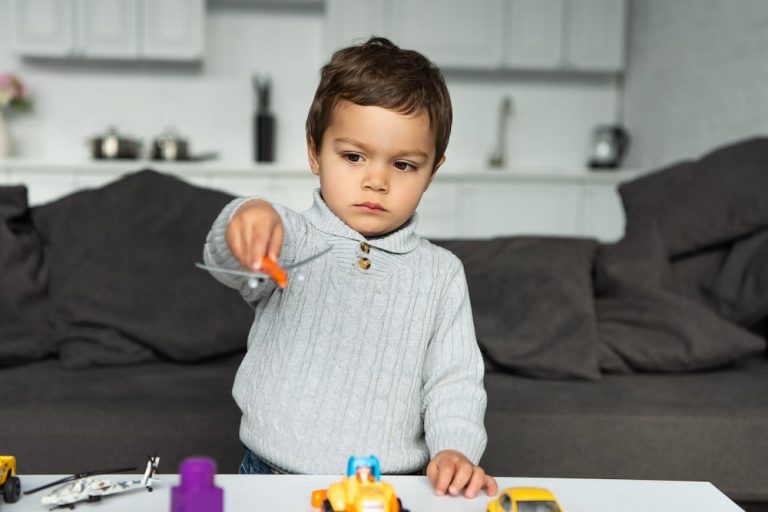Play is an important part of development. As children grow, they develop essential building blocks for cognition, language, and social-emotional skills. Do you remember playing Peek-a-Boo when you were younger or with a younger family member? Although the action of covering your eyes and then revealing them while yelling “Peek-A-Boo” may have seemed redundant, this play behavior teaches your child a number of important skills for growth.

Relationship Between Play and Language
Prior to language emerging as a form of communication, children must develop the ability to associate and represent reality with symbols and mental imagery. For example, have you had your child use lego blocks as cars? While the physical toy of a block is not a car, the block indicates that your child is using their imagination and mental imagery to associate the two together.
Without the ability to associate objects together, verbal communication becomes challenging as those foundational skills have not yet developed. Play and communication are interconnected.
Through play, here are examples of what children learn which helps grow their cognitive, language, and social skills.
- Joint Attention: Through play, your child develops the social skill of maintaining attention on the same object as their partner so a shared experience forms. For example if you were to tell your child, “look at the bird” and you both directed attention at the bluejay flying by- this is an example of joint attention in which both individuals intentionally engaged in socialization.
- Turn-Taking: While playing with toys, your child learns the turn taking exchanges involved similar to how people engage in conversation. For example, your child might roll a ball back and forth with you- this is an example of turn-taking.
- Cause and Effect: Your child develops their cognitive and language skills through the understanding of cause and effect relationships. For example with your child, you can stack blocks to build a tower while saying “up up up” and then when they say “down”, you can push the blocks to crash down.
- Flexible Thinking: As your child play skills continue to emerge, they will engage in pretend play in which they learn to compare and flexibly use the objects around them. For example, they might play with a toy kitchen pot to cook their food in and then use it as a phone to talk to a friend. This is an example of flexible thinking as the children use common objects for multiple uses.
Warning Signs of Speech Delay
As mentioned above, play and language are interconnected. Here are some warning signs that your child may exhibit a delay. If you are concerned about your child’s development, schedule a consultation below!
By 9 Months:
- Your child does not engage in turn-taking
- Your child does not respond to their own name
- Your child does not recognize familiar people
By 15 Months:
- Your child does not use any words to communicate with you
- Your child does not point to objects when verbalized
- Your child does not point to objects of interest when excited as to say “Look at this!”
By 18 Months:
- Your child does not notice when familiar people come and go
- Your child does not understand simple commands
- Your child is not using single words to communicate like “mommy” and “ball”
By 24 Months:
- Your child says less than 100 words in their repertoire
- Your child does not use 2-word combination such as “mommy up” or “bubble pop”
- Your child does not imitate gestures or words
- Your child does not engage in pretend play
By 3 to 4 Years:
- Your child does not use simple sentences
- Your child does not engage in questions
- Your child is unable to retell a simple story
- Your child does not engage in eye contact with others
- Your child does not want to play with other children
Tips to Encourage Language Development
If your child is exhibiting any of the warning signs above, try these speech and language strategies to promote language.
- Model– Try to model what you want your child to engage in. For example if you are “racing” your child with toy cars, model the action with the words “ready… set… GO” as you push your car.
- Add Words– When playing with your child, always try to expand on what your child is saying. If they say “bubble”, add an additional word to expand their utterance such as “bubble pop” or “bubble up”.
- Give Choices– Try to give your child an option of two so they use language to select desired item. For example, you can ask “Do you want bubbles or cars?”
- Ask Questions– While playing with your child, ask simple wh-questions such as “who”, “what, and “where”.
- Narrate– When playing with your child, it is recommended that you narrate what your child is doing. Your child will learn language through exposure around them. If he is playing with the toy car and pushes it into a tower of blocks, you might say “car bumped into tower uh-oh, tower fell down”.
- Promote Requesting– While this tip is challenging due to wanting to give your child what they desire, it is recommended that you wait until your child requests. For example if you notice that your child is trying to open their juice, wait until your child verbalizes or signs for “help”, “more”, or “open”.
Speech Therapy For Toddlers
It is recommended that if you have concerns related to your child’s speech and language development, please reach out to a speech therapist as early intervention is key to growth and success.
